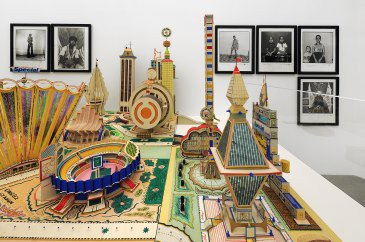Carsten Holler
Pierre Bodo
Cheri Samba
Pathy Tshindele
Jean Depara
Cheik Ledy
Bodys Isek Kingelez
Natsumi Nagao
Nobuyoshi Araki
Akihiro Higuchi
Kazuna Taguchi
Teppei Kaneuji
Hiroki Tsukuda
Keiichi Tanaami
4/2/2011
Japancongo
Magasin, Grenoble
Carsten Holler's double-take on Jean Pigozzi's collection. The two has conceived a scheme for a dual exhibition, confining the African contribution solely to the Democratic Republic of Congo, which is juxtaposed to the art from Japan. A long, straight wall nearly 40 metres long, is used as a hanging surface for the Japanese drawings, paintings. On the other side, a curved wall of the same dimensions, also opening onto small rooms, has been assigned to the artists from the DR of the Congo.

«When Jean Pigozzi asked me if I would like to be the curator of an exhibition for his collection of contemporary African art, I was at first sceptical. Only when he said that he also has recently built up a collection of contemporary Japanese art, I became really enthusiastic. Thatʼs exactly what I am looking for, a new Double Club of sorts.” Carsten Höller
Jean Pigozzi is a collector and a photographer, while the notion of “doubleness” is at the very centre of Carsten Höllerʼs life and his work as an artist. It seemed natural that their meeting would culminate in a joint project, with Jean Pigozziʼs collection constituting the raw material for Carsten Höllerʼs attempt to curate the exhibition in such a way that it also becomes an artwork in its own terms. The Pigozzi collection has been known for twenty years as one of the worldʼs foremost collections of contemporary African art. Over the past few years, however, Pigozzi has discreetly added over 500 works by young Japanese artists under thirty years of age to his collection.
Carsten Höller, along with Jean Pigozzi, has conceived a scheme for a dual exhibition, confining the African contribution solely to the Democratic Republic of Congo, which is juxtaposed to the art from Japan. It is the similar presence of art from one country next to the art from another country, with all their uniqueness and, at the same time, their common reference points. A long, straight wall nearly 40 metres long, is used as a hanging surface for the Japanese drawings, paintings and photographs. Three openings lead into small rooms behind, built for the display of Japanese sculptures and objects. On the other side, a curved wall of the same dimensions, also opening onto small rooms, has been assigned to the artists from the DR of the Congo. Both walls form a kind of corridor, which is most narrow in its middle part.
Sixteen Congolese artists (including Pierre Bodo, Chéri Samba, Pathy Tshindele, Jean Depara, Cheik Ledy, and Bodys Isek Kingelez) are thus confronted to 47 Japanese artists (including Natsumi Nagao, Nobuyoshi Araki, Akihiro Higuchi, Kazuna Taguchi, Teppei Kaneuji, Hiroki Tsukuda, and Keiichi Tanaami). The volume of Congolese works exhibited will be identical to the volume of the Japanese works.
The installation of the works is organized following subjective considerations on similarities and difference between the two groups, with the most “similar” art pieces installed there where the two walls come closest.
This architecture of duality generates a coexistence of two cultural identities that is central to Carsten Höllerʼs work. Symmetry and reduplication, which for instance echo the structure of Rorschachʼs test pictures, lead to the viewersʼ physical, sensory and mental displacement. Visitors can walk through the central corridor with the rooms and the hung pictures on either side, but they can also choose the reverse option, the exhibitionʼs negative double, and follow a route behind the walls that have been left untreated. The exhibition space becomes a spatial machine, an environment that impacts our perception of the exhibition space and its traditional reference points, by making the visibility of its makeshift structure a part of the experience, as if wandering through a Potemkin village.
JAPANCONGO relates to an earlier project of Carsten Höller, The Double Club, which he held open in London 2008/2009 for a period of 8 months. The bar, restaurant, and discotheque at The Double Club were all divided into equal Congolese and “Western” parts, both in terms of space (decoration and origin of furniture) and time (music, food). See www.thedoubleclub.co.uk for more information.
The Pigozzi collection offers a unique opportunity to extend this approach into the presentation of art, with reference to questions about the nature of collecting, the notion of origin, human forms of expression, and, perhaps above all, the assumption that all art has a common background, a language that cannot be translated into words but that becomes even more evident and understandable when cultural differences are made obvious. Some great works of art are shown here in a way that puts the emphasis on the connections.
Following le MAGASIN in Grenoble, the exhibition will be presented at the Garage Center of Contemporary Culture in Moscow in Summer 2011, then in Milan in September 2011 in the famous cariatides room of the Palazzo Reale, which shows the collections of the Contemporay Art Center. (Garage is a project of the Iris Foundation, a non profit foundation established by Daria Zhukova.)
Communication - Press
Laure Chataigner +33 (0)4 76 21 65 26, l.chataigner@magasin-cnac.org
Opening Saturday 5 February at 6pm
MAGASIN Centre National d'Art Contemporain
155 Cours Berriat Site Bouchayer-Viallet 38000 Grenoble
Opening times
Tuesday to Sundat, from 2 pm to 7 pm.
Tours on demand for groups in the mornings, from Tuesday to Saturday
Entrance fees
Normal 3,50€
Reduced 2€ (unemployed, disabled, senior, art teachers, ...).
Free for children under 10, Amis du Magasin members.



